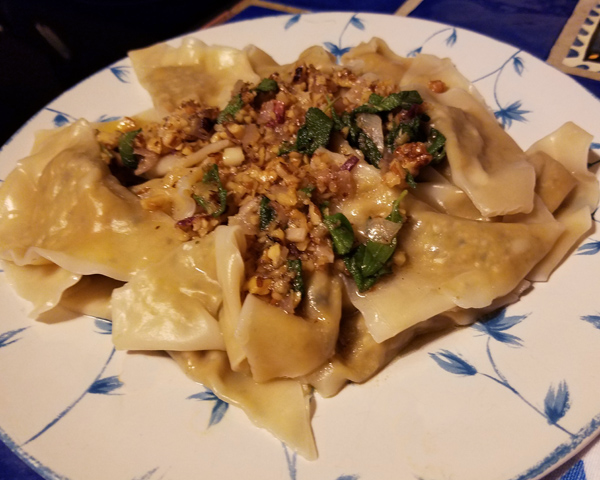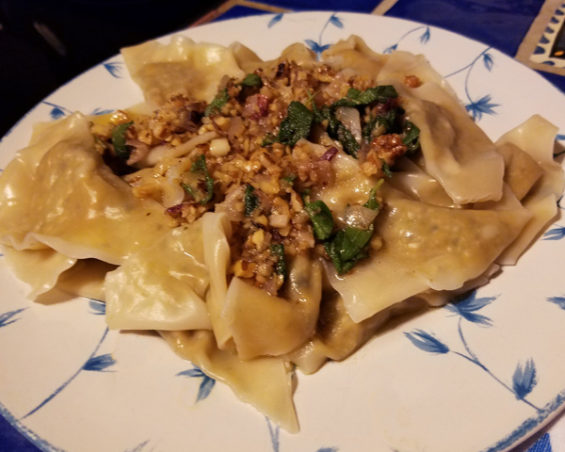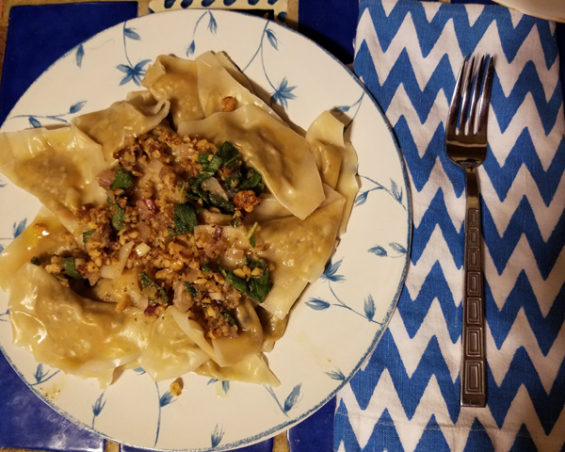Vegan Butternut Squash Ravioli with Tofu Ricotta and Brown Butter Sage Sauce


If you’re like me, when you go out to a restaurant, you typically order dishes you wouldn’t make for yourself at home. One of my restaurant faves is butternut squash ravioli—a toasty, fall-harvest-flavored treat that I would regularly comb bistro menus for . . . until I started eating non-dairy. Finding vegan butternut squash ravioli is about as easy as trying to walk through the TSA with a piece of foil-wrapped wedding cake (no joke—just ask my sister), so I’d mostly given up on eating this dish again. Then some leftover butternut squash and a package of wonton wrappers got me thinking. . . .
Turns out plenty of people had this idea before me, albeit with dairy cheese. Still, their recipes were the inspiration for my own vegan butternut squash ravioli, with a velvety brown butter sage sauce. Most recipes call for hazelnuts in the sauce, but I was out and substituted walnuts, and they turned out to be the perfect foil: their fat content adds an extra layer of richness, while their slightly bitter flavor beautifully balances out the sweetness of the filling.
Because this is a multistep recipe, I recommend making the ricotta, or both the ricotta and roasted squash, the night before you plan to serve the dish, to cut down on day-of prep time. Round wonton wrappers look prettier, but square, which tend to be more common in supermarkets, can be used as well, and that’s what you’ll find here.
Roasted Butternut Squash and Vegan Ricotta Ravioli with Brown Butter Sage Sauce
Serves 4 as small plates

For the tofu ricotta (adapted from The Non-Dairy Evolution Cookbook by Skye Michael Conroy):
1 block (14 oz) extra-firm tofu
3/4–1 cup unsweetened, unflavored almond milk
2 tablespoons olive or canola oil
1/2 teaspoon Himalayan sea salt
1/4–1/2 teaspoon ground pepper
1 teaspoon dried parsley
2 teaspoons fresh lemon juice
For the squash:
2 cups butternut squash, cubed
Olive oil
Salt and pepper to taste
For the ravioli “pasta” and sauce:
1 package wonton wrappers
Approximately 1/3 cup vegan butter, such as Earth Balance
1/4 cup walnuts, chopped
2–3 tablespoons fresh sage, chopped or julienne
- Drain and press the tofu, about 30 minutes. Wrap it in a paper towel and give it one final squeeze. With your hands, break up the tofu into a food processor. Add about 1/2 cup of the almond milk, the lemon juice, sea salt, pepper, and parsley, and process until mostly smooth. If needed, continue adding the remaining almond milk in a slow stream. Scoop the tofu ricotta into a container, cover with a lid, and refrigerate for at least 3 hours.
- Preheat the oven to 400°F. Toss the squash with enough olive oil to lightly coat. Spread out in a single layer on a baking sheet, and sprinkle with salt and pepper. Roast for about 30 minutes, turning halfway to brown evenly. Remove from the oven and allow to cool.
- Scoop the cooled squash into a bowl and mash with a fork. Add about half of the tofu ricotta and stir until well blended. Add more ricotta as needed, until you reach a half squash, half ricotta blend.
- Moisten the edges of a wonton wrapper with lukewarm water, then scoop a heaping teaspoon of the filling a little below the center line. Fold the wonton in half and press the edges together. If using round wontons, use the flat bottom of a fork’s tines to press the edges into each other and give a crimped look to the ravioli. If using square wontons, fold in the pointed edges to prevent filling from escaping out the sides. Repeat with all remaining wontons.
- Add the vegan butter to a skillet and turn the heat to medium. When the butter melts and begins to sizzle, add the walnuts and cook for about 3 minutes. Add more vegan butter, if needed, to create a thickened yet still easily pourable sauce. Remove the pan from the heat and stir in the sage.
- Bring a pot of salted water to a boil. Carefully drop in the ravioli and boil for 3 to 5 minutes, until tender. Use a slotted spoon, rather than a colander, to gently drain the ravioli and arrange on plates. Pour equal portions of the sauce over each plate, and serve immediately.